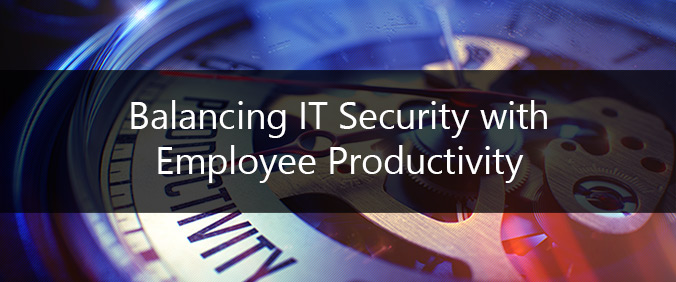
Balancing IT Security with Employee Productivity
Many businesses already know that IT security is critical to mitigating financial risk. Employees know it, too; however, even the most security-minded staff can bypass security protocols when attempting to meet workplace demands and tight project deadlines. How can businesses keep sensitive data secure; while making it as possible for your employees to remain productive? There is a balance to strike between security and employee productivity.
Employee Productivity and IT Security Can Co-exist
IT security protocols will fail if they are too complex and it employees feel they need to bypass security measure to meet workplace demands. In a recent study conducted by Dell 91 percent of employees—both IT staff and end users—said that their the company’s security protocols have had a negative impact on their productivity. Businesses can help make employees partners, rather than adversaries, in securing a network environment by focusing in three areas:
- Tools and automation that allow security to work behind the scenes.
- Providing easy access to best-in-class IT support and incident response resources.
- Training to guide employees’ understanding of corporate security standards.
1. Tools and Automation
Passwords are one of the most widely-used, yet severely neglected, security measures in any organization. A 2015 ComputerWorld article noted that “87% of users have to remember multiple user name/password combinations (most report having two to five combinations, with some reporting that they use more than 10).” Add to this, the fact that many organizations require password changes on sensitive systems as often as every three months, and you can see where technology like single sign-on (SSO) could help boost productivity. SSO and identity-management solutions like Okta, are simple and effective solutions that allow users to sign-on to multiple systems from a single web-based user interface. This helps meet both objectives: (1) maintaining a secure IT environment while simultaneously promoting user productivity.
2. Employee Support
Oftentimes, when users contact a help desk, they’re already frustrated—because they couldn’t fix the problem themselves and because their work has ground to a halt. So, a responsive, knowledgeable help desk goes a long way towards keeping employees productive and less likely to find a workaround of their own—one that may circumvent IT security layers.
A reputable IT security provider’s help desk will have the following characteristics:
- Timely communication, both on initial contact and on status updates.
- Quick and accurate problem resolution.
- Access to after-hours support.
- A way to ask for customer feedback and measure satisfaction.
3. Training
If you want your employees to be partners in your company’s IT security effort, they need to learn how. IT security training, ideally delivered at the user’s convenience, goes a long way towards ensuring compliance with internal security protocols. Virtual training often fits the bill: It requires no travel, allows users to learn at their convenience, and offers organizations a way to measure accountability.
If you run a small-business, this balancing act between IT security and employee productivity may seem overwhelming. However, the IT security experts at All Phases IT can help. Simply, contact us today for a complimentary 30-minute security consultation and evaluation of your current IT security practices.



